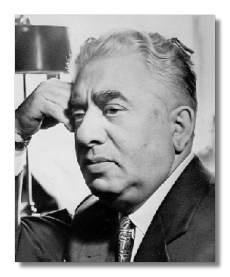
The Internet's Premier Classical Music Source
Related Links
-
Find CDs & Downloads
Amazon - UK - Germany - Canada - France - Japan
ArkivMusic - CD Universe
Find DVDs & Blu-ray
Amazon - UK - Germany - Canada - France - Japan
ArkivMusic-Video Universe
Find Scores & Sheet Music
Sheet Music Plus -
Recommended Links
Site News
Aram Khachaturian

(1903 - 1978)
Aram Il'ich Khachaturian (June 6, 1903 - May 1, 1978) was born in Tbilisi into a relatively comfortable middle-class family. Although he had always enjoyed the Armenian folk music, he showed no interest in pursuing a career in music until, at the age of 19, he approached the composer Mikhail Gnesin to give him lessons in composition. This led to his attending the Gnesin School of Music in Moscow (then known as Moscow Conservatory) where he came under the influence of Nicolai Myaskovsky. By then he was already writing his own music, mainly small pieces for piano, which showed a pronounced Asiatic character.
As he entered his fourth decade, he had gained sufficient confidence to attempt more ambitious music, moving from the rustic Armenian Folksong and Dance for wind orchestra of 1932 to his first full symphony in 1934. This work was a decided success – no mean feat in the critical climate of Soviet Russia at that time – and established him as a composer to be reckoned with. Its astute combination of folk-like elements and tidy musical development in relatively conservative idioms made it difficult to criticize. More dramatic in impact was the Concerto for Piano and Orchestra of 1935-36 which won fulsome praise. The work uses every instrument of a large orchestra, making it a spectacular concert hall piece. Its popularity in the Soviet Union was immediate and permanent, and when it was introduced to American audiences in 1942, it quickly became a staple part of the performing repertoire of a number of pianists, rapidly making the transitions to records.
Khachaturian followed this concerto with another, the Concerto for Violin and Orchestra in D minor (1940), which was equally successful in the Soviet Union. It not only won the Stalin Prize but the advocacy of the brilliant young violinist, David Oistrakh. Khachaturian had carefully balanced his folk-like elements with the type of virtuosity which appealed to top-flight violinists, and the work is still heard regularly in concert halls. The onset of what the Soviets called the Great Patriotic War did not find Khachaturian wanting, and his Second Symphony, subtitled The Bell (1943), contained a third movement which the composer felt conveyed "the superhuman sufferings caused to the Soviet people by the Nazi monsters". The Moscow premiere in 1943 was a great success, and within a year it was introduced to America by Leonard Bernstein.
By this time Khachaturian had become indissolubly linked with the Armenian roots, and his first ballet, Gayaneh, named in honor of an Armenian saint, set great store by this heritage. Some of the dances are positively rustic, the rhythms violent and marked with clanging percussion, the melodies extremely vocal. Khachaturian made no bones about using as many kinds of Armenian dance as he could fit into the score, which runs for over an hour in its uncut version. The famous Sabre Dance has taken on a life of its own, played so often out of context that few who hear it are able to name its composer or the ballet from which it comes.
After this phenomenal world-wide success, Khachaturian found himself caught in the web of his own success, and though he wrote another symphony (1947), a cello concerto of distinction (1946) and various chamber works during his prolific career, he became typecast as a composer of folk ballets and theatre music. In 1943 he attempted to repeat his success with Gayaneh by mounting the ballet Spartacus (1943), which did enjoyed a brief time in the sun, but is now usually heard only in highlights, especially the overture. Throughout the 1940s and 1950s he wrote a number of excellent film scores, using his innate gift for music drama.
Like most Soviet composers of any worth, Khachaturian suffered in the attack launched in 1948 by the Central Committee of Communist Party against so-called "anti popular trends" and the sin of "formulism". He was one of the few to criticize his critics publicly, winning for his colleagues some respite from the suffocating attention of Stalin's cronies. In 1951 he was appointed Professor of composition at Moscow Conservatory and at his old college, the Gnesin School, retaining both posts until his retirement. Khachaturian's music did not benefit from a great latter-day wellspring of inner renewal, and long before his death he had become a man venerated for his early achievements rather than for the later repertoire. Yet even his least inspired scores were cleverly realized and had lessons to teach any student of modern composition.
Recommended Recordings
Concerto for Piano
- Piano Concerto in D Flat Major; Gayaneh & Masquerade Suites/Chandos CHAN8542
-
Constantine Orbelian (piano), Neeme Järvi/Scottish National Orchestra
- Piano Concerto in D Flat Major; etc./Academy Sound & Vision CDDCA964 or PLT8510
-
Dora Serviarian-Kuhn (piano), Loris Tjeknavorian/Armenian Philharmonic Orchestra
Amazon - UK - Germany - Canada - France - Japan - ArkivMusic - CD Universe
Reissued as AS&V PLT8510:
Amazon - UK - Germany - Canada - France - Japan - ArkivMusic - CD Universe - Piano Concerto in D Flat Major; Concert-Rhapsody/Naxos 8.550799
-
Oxana Yablonskaya (piano), Dmitry Yablonsky/Moscow Symphony Orchestra
Concerto for Violin
- Violin Concerto in D minor/Chandos CHAN8918
-
Lydia Mordkovitch (violin), Neeme Järvi/Scottish National Orchestra
- Violin Concerto in D minor/EMI CDC747087
-
Itzhak Perlman (violin), Zubin Mehta/Isreal Philharmonic Orchestra
Gayane (ballet)
- Suite "Gayane"/Vanguard OVC5010
-
Vladimir Golschmann/Vienna State Opera Orchestra
- Ballet "Gayaneh" (4 Movements from Suite #1); Piano Concerto/Chandos CHAN8542 or CHAN8945
-
Neeme Järvi/Royal Scottish Orchestra













